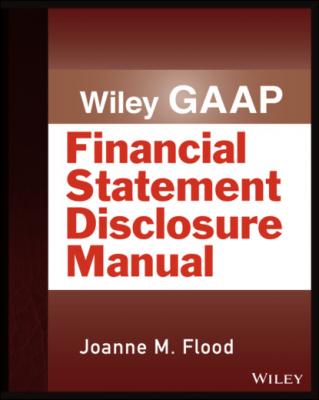Wiley GAAP: Financial Statement Disclosure Manual. Joanne M. Flood
Читать онлайн.| Название | Wiley GAAP: Financial Statement Disclosure Manual |
|---|---|
| Автор произведения | Joanne M. Flood |
| Жанр | Бухучет, налогообложение, аудит |
| Серия | |
| Издательство | Бухучет, налогообложение, аудит |
| Год выпуска | 0 |
| isbn | 9781119365723 |
AUTHORITATIVE LITERATURE
Subtopic
ASC 235, Notes to Financial Statements, contains one Subtopic:
ASC 235‐10, Overall, which addresses “the content and usefulness of the accounting policies judged by management to be most appropriate to fairly present the entity's financial statement.”
Scope
ASC 235 applies to all entities and has no scope exceptions.
Disclosure Techniques
When preparing disclosure notes, entities should consider the purpose of the disclosure—to provide users with information that assists them in assessing the entity's performance and cash flow. The notes should enhance the information presented on the face of the financial statements, provide clarity, and be organized in a logical manner. Entities should also word notes in plain English, consider tabular formats, and cross references.
The following five disclosure techniques are used in varying degrees in contemporary financial statements:
1 Parenthetical explanations
2 Notes to the financial statements
3 Cross‐references
4 Valuation allowances (sometimes referred to as “contra” amounts)
5 Supporting schedules.
Parenthetical Explanations
Information is sometimes disclosed by means of parenthetical explanations appended to the appropriate statement of financial position caption. Parenthetical explanations have an advantage over both notes to the financial statements and supporting schedules. Parenthetical explanations place the disclosure prominently in the body of the statement instead of in a note or schedule where it is more likely to be overlooked. For example:
Example—Parenthetical Explanations
| Common stock ($10 par value, 200,000 shares authorized, 150,000 issued) | $1,500,000 |
Notes to Financial Statements
If the information cannot be disclosed in a relatively short and concise parenthetical explanation, a note disclosure is used. For example, see the following.
Example—Internal Reference to Note
| Inventories (see note 1) | $2,550,000 |
The notes to the financial statements would contain the following:
Note 1: Inventories are stated at the lower of cost or market. Cost is determined using the first‐in, first‐out (FIFO) method.
Cross‐References
Cross‐referencing is used when there is a direct relationship between two accounts on the statement of financial position. For example, among the current assets, the following might be shown if $1,500,000 of accounts receivable were pledged as collateral for a $1,200,000 bank loan.
Example—Cross‐References to Other Line Items
| Accounts receivable pledged as collateral on bank loan payable | $1,500,000 |
Included in the current liabilities would be the following:
| Bank loan payable—collateralized by accounts receivable | $1,200,000 |
Valuation Allowances or Contra Accounts
Valuation allowances are used to reduce or increase the carrying amounts of certain assets and liabilities. Accumulated depreciation reduces the carrying value of property, plant, and equipment, and a bond premium (discount) increases (decreases) the face value of a bond payable as shown in the following illustration.
Example—Valuation Allowances or Contra Accounts
| Equipment | $18,000,000 | |
| Less accumulated depreciation | (1,625,000) | $16,375,000 |
| Bonds payable | $20,000,000 | |
| Less discount on bonds payable | (1,300,000) | $18,700,000 |
| Bonds payable | $20,000,000 | |
